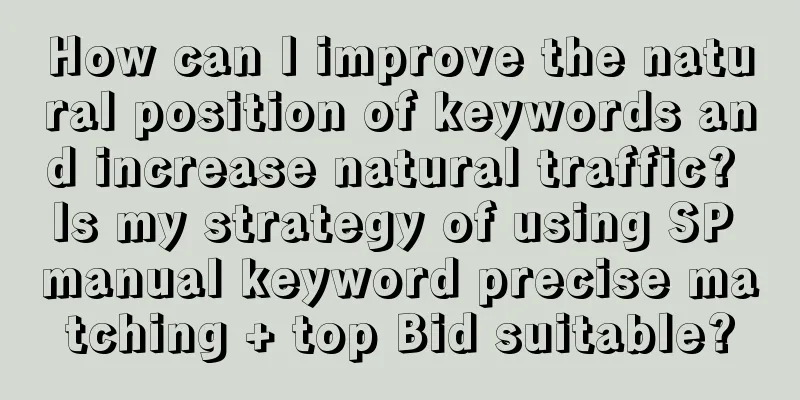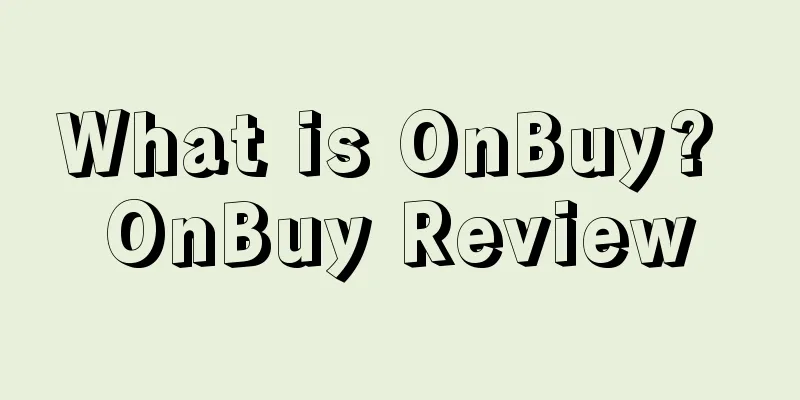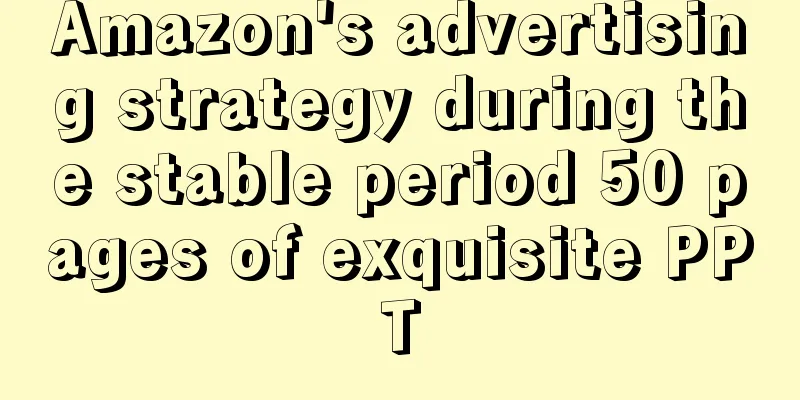|
I would like to ask all the experts to help answer my questions! My colleague and I are promoting a new product at the same time. We are both advertising at this stage.
I checked S*F and found that his product has a lot of traffic words, including natural traffic words. But I have few traffic words, and even fewer natural traffic words.
I have discussed with him. He is currently focusing on automatic advertising, which has high investment, high click-through rate and low conversion rate. SP manual keywords also use phrase matching, but there is not much exposure. In general, he is currently focusing on automatic advertising.
I checked these traffic words, and they are basically words with poor relevance, but they include some big words with very large search volumes.
Compared with mine, I mainly use SP manual keyword precise matching + top Bid, and the word bidding is relatively high. Because the search volume of core words and long-tail words is relatively low, the overall exposure and clicks are not as many as automatic ones. At the same time, phrase matching and automatic advertising are also turned on, and all words are core words and long tails.
Through manual search, there are no advertising and natural positions in the first three pages of the core words.
My question now is, what should I do next to increase traffic? Please help me answer my questions, thank you very much!
"Wonderful Reply"
The Three Lucky Treasures Victims - Post-95s Agree from: Daniel Jiapeng 1. First determine your product positioning, whether it is a standard product or differentiated, and whether there are similar products at the top. If your product is differentiated and the audience is not wide, then there is no need to insist on getting the top position, because it cannot handle such a large amount of traffic.
2. Secondly, determine your expectations for the product. Whether you want to be in the top or the middle position, the advertising strategies for the two are also different. The top position of the advertisement is the fastest strategy to improve the natural ranking, which is suitable for the top position. If you want to be in the middle position, you can actually go to other positions, but it is difficult to control the position, and there will be great fluctuations in the early stage.
3. You are not in a hurry to expand traffic now, you need to solve the conversion rate problem first. If your conversion rate is so low, first check whether it is on the product page. If not, check the content of your listing and whether the price is too high. Make sure that the link content and price are correct before adjusting the ad position.
4. Now many ads for new products are placed at the top right after they are released (lower the bid and increase the top percentage), which may cause poor data and result in not being able to reach the top later. You can use a fixed method, raise the bid and do not add a percentage; or increase or decrease the top percentage by 10%-20%. In this way, you can gradually adjust the ad position. Anonymous User • Shenzhen • 55 minutes ago It is a standard product, and there are many similar products at the top. Because the product I promote is a high-priced product, but it has a high cost-effectiveness in the same category. I have always been bidding high + bid percentage, but there is no exposure. I am currently trying to break through the traffic problem through various other bidding strategies and matching methods, not just focusing on the top.
Jixiang Sanbao victims • Shenzhen • 45 minutes ago @Anonymous User I don't understand your category. But logically speaking, if your conversion rate is low, it will be difficult for Amazon to allocate traffic to you, or your ads will be less and less popular. Because in the same position, exposing other competing products can bring more revenue to Amazon. If you are sure that there is no problem with the conversion, you can quickly increase or decrease the traffic. But your conversion rate cannot be normal no matter how you look at it~~
Panipai Agree from: yebozzz , R123321 I think the early stage of new products is still mainly for collection. So I usually turn on the automatic mode first, first to test whether there is any problem with the listing, and secondly, the automatic CPC is low and the range is wide. If the word is off, it must be a problem with the listing, or your traffic word is not accurate, and Amazon's judgment is vague. You still need to use more negative words in the automatic mode to negate irrelevant words that may appear in advance. If you think the automatic mode is too complicated, you can try the wide range of big word roots. However, you still need to pay attention to the negative words for this kind of early collected advertisements, so that Amazon can accurately identify the traffic word you want.
R123321 Agree from: yebozzz 1. Because it is a new product, the click-through rate will also have an effect on increasing the keyword ranking, so his number of keywords and scores are higher than yours
2. At the beginning of the new product period, you still need to include more. There is nothing wrong with the strategy of low bidding and high clicks. You may be a little too hasty to open core long-tail keywords in this advertisement
3. If you don't know the unit price of your product, the click-through rate and conversion rate are low. It is recommended to allocate more budget to automatic, fix a group of low bids, increase and decrease bids, keep one core long-tail word, and optimize the product page and price at the same time.
yebozzz I have the same problem, I'd like to hear your opinions.
Let me raise a few questions first:
1. Is the link a new product? A 5-star rating is good, but there are only 6 ratings. Are all 6 reviews or dotted stars? Could this be one of the reasons for the poor conversion rate?
2. What period of time does the data in Figure 3 come from? Is it the most recent week?
3. CPC is quite high regardless of whether it is automatic or precise. The competition in the category should be fierce. Are the ads mainly at the top? If there is no conversion at the top, it means that the competitiveness is not enough. Will the ads collapse if we continue to push them? The click-through rate seems normal. There is still too little precise advertising data, after all, there are not many clicks. Anonymous user • Shenzhen • 21 hours ago 1. It is a new product link with 6 full-star reviews. 2. The data in Figure 3 is for 30 days (I forgot to take a screenshot) 3. Currently, there are no advertising or natural positions on the first three pages.
yeboz zz • Shenzhen • 20 hours ago @Anonymous user 2. The 30-day data is still too small. There are only about 10 clicks in each group. It is normal that there is no conversion. Can the precise bidding and budget be increased? 3. What I want to express here is that the click position is at the top/other positions/product page.
All I can say is “There are no ads or organic placements on the first three pages.” The keyword weight has not risen yet.
Anonymous user • Shenzhen • 20 hours ago @yebozzz: Yes, the core long-tail keywords of the product have a relatively small search volume and high bids. The bid I gave is also quite high. The main reason is that it is difficult to be exposed. There are too few included and the weight is too low. My colleague has a lot of words automatically included, but they are basically irrelevant or big words.
Gezelligheid • Shenzhen • 20 hours ago @Anonymous user: If the exposure is not enough, run as many ads as possible. Don’t set the budget too high. Set a fixed bid and let the budget run out. In this way, the exposure will generally not be low. The listing also needs to be continuously optimized. Double cooperation
z1 2121 • Shenzhen • 2 hours ago I feel the same way when promoting new links now. If the product does not have obvious advantages and accumulation, and if you force it to be accurate at the beginning, there will be very few included words, and the traffic growth will be very slow. On the contrary, automatic running will be much better and will not waste too much money. Your colleague's deviation is a problem at the link level.
Anonymous user • Shenzhen • 1 hour ago @z12121: I am currently planning to use a wide range of bidding strategies to try to overcome the problem of traffic not coming in. This problem is difficult to solve automatically, which is a headache.
Anonymous user • Shenzhen • 1 hour ago @我就是馨月呀: There are only a few hot and precise keywords in this category, and the popularity is relatively low. The long tail is even lower. The price is also very cost-effective. The pictures are currently waiting for new pictures. The full stars but the quantity is relatively small.
Enzoy00-1111 First explain that you and your colleagues are promoting the same new product:
1. Are you promoting new products on the same site? If so, please analyze your strategy. Since I didn’t post your colleague’s advertising data for the same period, I can only see from the sif traffic data and your explanation that the difference is mainly in the size of the keywords. Your colleague’s main force was big keywords in the early stage (although it was not accurate enough for product conversion), but he had more clicks, and the traffic capture was definitely much more than yours for long-tail keywords (regardless of whether the word type is related to the link itself).
2. According to your own advertising data indicators, automatic advertising only receives clicks but no orders. First, it may be related to the completeness of your listing, market bidding, and rating. It is recommended to reconsider the operation of embedding keywords. Second, whether the overall exposure meets the standard in the category. The indicator of the click rate is obviously not up to standard. It is recommended to start with the main picture, bidding, and ad position.
3. The core long-tail words are not accurate enough. If the indicators are found to be unsatisfactory in the early test words in the later stage, other words can be operated.
Handwritten Once Upon a Time 111 1. First, you need to determine whether your exposure location is on the homepage, other pages, or product pages
2. You can see that the automatic advertising has been running for a month with 60 clicks but no orders have been made. Is it because there is a problem with the keywords or writing of your listing that caused the automatic advertising to go astray?
3. Secondly, the exposure is compared with your click rate. The main picture has a low click rate. Does it need to be improved?
4. Is your CPC a high-priced product? The conversion rate of 5-star reviews is so low. Are there any A+ reviews with pictures or videos in the main picture and video?
(Just a little assistant) I hope it can be of some help to the OP Anonymous user • Shenzhen • 19 hours ago 1. Product pages are the most exposed, followed by other pages, and very few at the top.
2. The relevance of the automatic results is very poor, there are many irrelevant traffic words, and the listing buried words are also core words. At present, automatic advertising is also a headache for me. I want traffic exposure, but I don’t want too much invalid traffic and invalid words from the link income.
3. The picture needs to be optimized. We are currently waiting for the picture to come out.
4. It is a high-priced product, new pictures are still waiting, and the main picture video has not been arranged.
Handwritten Once Upon a Time 111 • North America • 19 hours ago @Anonymous user, I personally feel
1. Normally, the product page has the most clicks, followed by other pages, and very few at the top. At this time, you need to see where your clicks appear.
2. I have run a lot of irrelevant keywords. If the relevance is very poor, you can turn off your broad keywords and let the close keywords run first. I am not sure how to choose the two characteristics of relevance and traffic size.
3. Listing is very important. If it is not optimized, there will be no conversion even if you click on it. Ads are just traffic tools.
4. I saw that you said you wanted to use long-tail keywords but didn’t get exposure. However, the traffic of long-tail keywords themselves is relatively small. I don’t know if you have checked the data of ABA. I am not sure whether you are going from big keywords to small keywords or something else. Once the listing is ready, you can use any keyword you want (of course, I don’t know the situation of competing products).
Daniel Jiapeng - Post-95 Amazon Operations Don't think about natural traffic now. The premise of increasing natural traffic is that your product ranking must go up. Now your ad conversion is low, click-through rate is low, CPC is high, category volume, new products, no screenshots of ad space, you should consider whether the current product weight can't bear the traffic brought by this CPC bid, the competition between product page and top is very fierce, if you just want to push violently, just ignore what I said
If you are looking for conversion, you can work hard on other positions, and use CPC and bid+ to make more clicks appear in other positions. If the keywords that appear in automatic advertising are not relevant, check whether they appear more broadly. If so, lower the price or turn it off. If not, there is something wrong with the listing, so check it yourself. As for the keywords you typed, you can check it through aba. If it is a new product, the conversion rate will definitely be low if you directly target big keywords. Consider whether to change the keywords.
Anonymous user My situation is similar to that of the poster. I started selling for half a month. In the first week, I mainly used automatic close search + two manual broad search. The words that came out automatically were not off track and were very accurate. However, no matter whether it was automatic close search or manual broad search, the words that came out were the kind with a few impressions. As for the ad space, I could search for some main words on the homepage in the first three days, but I couldn't find any in the next few days (I didn't adjust the ad campaign in the middle).
I spent too much on advertising in the first week, and was criticized. In the next week, I turned off the automatic close, and opened manual broad matching for 3 big words and manual precise matching for 2 long-tail words, but the exposure of precise words was very low, and the other broad groups with high exposure had very poor clicks; sales were even worse. Now I just add bids every day according to the exposure situation. I don’t know how to adjust the rest. Please give me some advice.
Gezelligheid Different products have different audiences and traffic sources. Your click-through rate is low, which is probably due to the listing pictures. It is recommended that you optimize the listing pictures first and then conduct tests. Advertising can get greater exposure and promote orders based on the listing. Anonymous user • Shenzhen • 19 hours ago The pictures do need to be optimized. The problem now is that because I mainly target long-tail core words, some long-tail words have high bids but still have no exposure. Do I need to change my mindset? My main confusion is that the exposure of long-tail core words is limited. There are a lot of automatic exposures but the relevance is particularly poor. Now I am worried that the links will not hold if I target some core general words or words with large traffic. I don’t know where I should get more exposure and clicks next.
Gez elligheid • Shenzhen • 19 hours ago If you optimize your listing keywords a little bit, and the relevance and keywords are normal, change your thinking, reduce the original automatic advertising budget, and reopen the automatic tight, let the system collect your product listing information first, and if the exposure is effective, turn off the original automatic, and add the budget to the effective new ads. If you click on this part, it will be highly relevant to the main picture. First, optimize the main picture when the exposure is normal, and clicks will bring
|










